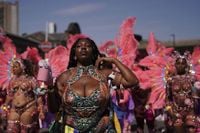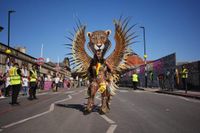The streets of west London exploded into a riot of color, sound, and movement as the Notting Hill Carnival returned for its 57th year, drawing an estimated two million revelers for what has become the largest celebration of Caribbean culture in Europe. Over the weekend of August 23 to August 25, 2025, the district was transformed, with soca, calypso, reggae, and dancehall music pulsing from every corner, the aroma of jerk chicken and fried plantains wafting through the air, and parade-goers donning costumes so vibrant they seemed to outshine the summer sun itself.
Since its inception in 1966, the Notting Hill Carnival has grown from a small community gathering to an international spectacle, celebrating the diversity and enduring contributions of West Indian immigrants—especially the Windrush generation—to British society. According to the Associated Press, the two-day street event now attracts not just Londoners, but visitors from across the UK and beyond, all eager to experience what has become one of the world’s largest carnivals.
This year’s festivities were not without their challenges. The sheer scale of the event, with around two million attendees and thousands of musicians and dancers taking part, required a massive logistical effort. Approximately 7,000 police officers and staff were on duty each day to ensure the safety of revelers and manage the enormous crowds, as reported by the Associated Press. The sheer presence of law enforcement underscored the event’s significance—and the complexities involved in pulling it off.
For many, the heart of the carnival is the parade, a dazzling procession of floats, steel bands, and costumed dancers. Some costumes were so elaborate they became instant icons, like the participant dressed as a lion, whose arrival was captured by photographers and widely shared in the media. The London Evening Standard’s vivid photo gallery showcased feathers, sequins, and masks in every hue imaginable, highlighting the artistry and exuberance that define the event.
But the carnival is not just about spectacle; it’s a living, breathing testament to resilience and cultural pride. The music—blaring from DJ sound systems perched on street corners—ranged from the infectious rhythms of soca to the deep basslines of reggae and dancehall. These genres, deeply rooted in Caribbean history, have become anthems for generations of Londoners, uniting people of all backgrounds in a shared celebration.
Yet, as the crowds danced and the steel pans rang out, a shadow loomed over the future of the event. According to reporting from the BBC, local authorities have raised urgent concerns about a funding crisis that threatens the carnival’s sustainability. Organizing an event of this magnitude requires significant resources for security, crowd control, and clean-up—costs that have ballooned in recent years. Local officials have called on the national government to step in with additional support, warning that without increased funding, the carnival’s future may be in doubt.
Transport for London (TfL) faced its own set of challenges, as the influx of visitors led to sweeping changes in public transportation. As detailed by The Mirror, major tube stations in the area were either closed or operated under strict entry restrictions to manage the flow of passengers safely. Ladbroke Grove station, for instance, was closed all day during the event, while other stations like Latimer Road, Notting Hill Gate, Westbourne Park, Holland Park, Royal Oak, Shepherd’s Bush, and Kensal Green saw a mix of closures, entry restrictions, and crowd control measures. Temporary closures and diversions were the norm, and even experienced Londoners found themselves consulting maps and apps to navigate the maze.
Buses, too, were rerouted or suspended in the immediate area, with dozens of routes—including the 2, 7, 16, 18, 23, 27, 28, 31, 36, 46, 52, 70, 94, 98, 148, 205, 220, 228, 295, 316, 328, 332, 414, 452, and several night buses—diverted to avoid closed streets. Limited-stop services, such as the 148X to Victoria and the 7X to Paddington, were introduced to help ferry revelers to and from the festivities. TfL even partnered with Metroline and the local community group Phoenix Rising to unveil a specially-wrapped Carnival bus, which featured in the parade itself. Onboard, Metroline staff, TfL employees, and live steel pan musicians entertained passengers, adding yet another layer of Caribbean flair to the proceedings.
Emma Strain, TfL’s Customer Director, summed up the spirit of the occasion, saying, “For many years Notting Hill Carnival has represented London’s diverse culture and strong Caribbean links—a community which is an integral part of TfL’s history.” She encouraged festival-goers to plan their journeys in advance, noting, “Stations around the Carnival are likely to get extremely busy, so please plan journeys in advance using the free TfL Go app or our dedicated travel advice page.”
For those who braved the crowds and transport snags, the rewards were undeniable. The parade was a feast for the senses, with steel bands clanging joyfully, dancers moving in perfect sync, and onlookers joining spontaneous street parties. Vendors lined the streets, offering everything from spicy patties to sweet rum punch, and impromptu dance-offs broke out at every turn. The sense of community was palpable—strangers became friends, and the boundaries between performer and audience blurred in the shared joy of the moment.
Yet, beneath the surface, the carnival remains a powerful reminder of London’s complex history with immigration, integration, and identity. The event was originally created as a response to racial tensions and discrimination faced by West Indian immigrants in the post-war years. Today, it stands as a testament to the enduring strength and creativity of those communities, while also highlighting the ongoing challenges they face—from funding shortfalls to questions of public safety and inclusion.
Photographs from the event, such as those published by the London Evening Standard, captured both the spectacle and the spirit of the carnival: a participant in a lion costume striding confidently down the street; a group of dancers mid-twirl, their costumes a blur of feathers and beads; children perched on their parents’ shoulders, eyes wide with wonder. These images tell a story of joy, resilience, and cultural pride that words alone can scarcely capture.
As the sun set on another Notting Hill Carnival, the crowds slowly dispersed, leaving behind confetti, empty food containers, and the lingering echoes of steel drums. For a few days, at least, west London became a world apart—a place where differences were celebrated, history was honored, and the future, despite its uncertainties, felt just a little bit brighter.


